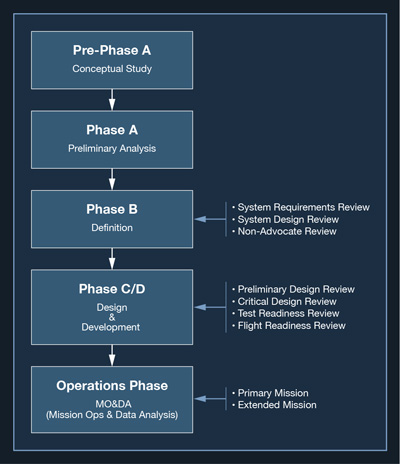Chapter 7: Mission Inception
Upon completion of this chapter you will be able to describe activities typical of the following mission phases: conceptual effort, preliminary analysis, definition, design, and development. You will be conversant with typical design considerations included in mission inception.
In this discussion, we will consider science projects suitable for sponsorship by the U.S. National Aeronautics and Space Administration (NASA). While a large percentage of projects at JPL enjoy sponsorship by NASA, many JPL projects do have different sponsors. This discussion considers a hypothetical example, and it is effective in offering a valid basis for comparison to real-world projects. In reality though, there may be many deviations from this nominal process.
There is no single avenue by which a mission must be initiated. An original concept for a mission to obtain scientific data may come from members of the science community who are interested in particular aspects of certain solar system bodies, or it may come from an individual or group, such as a navigation team, who know of a unique opportunity approaching from an astronomical viewpoint. As a project matures, the effort typically goes through these different phases:
- Pre-Phase A, Conceptual Study
- Phase A, Preliminary Analysis
- Phase B, Definition
- Phase C/D, Design and Development
- Phase E, Operations Phase
Formal reviews are typically used as control gates at critical points in the full system life cycle to determine whether the system development process should continue from one phase to the next, or what modifications may be required.
A person or group petitions NASA with an idea or plan. The proposal is studied and evaluated for merit, and, if accepted, the task of screening feasibility is delegated to a NASA Center. In the case of robotic deep space exploration, that center is frequently JPL. Sometimes it is APL, or another center.
Prior to Phase A, the following activities typically take place: NASA Headquarters establishes a Science Working Group (SWG). The SWG develops the science goals and requirements, and prepares a preliminary scientific conception of the mission. Based on the high-level concept and the work of the SWG, a scientific document called the Announcement of Opportunity, (AO) is sent out by NASA Headquarters to individual scientists at universities, NASA centers, and science organizations around the world. The AO defines the existing concept of the mission and the scientific opportunities, goals, requirements, and system concepts. The AO specifies a fixed amount of time for the scientific community to respond to the announcement.
All proposals for new experiments are reviewed for science merit as related to the goal of the mission. Mass, power consumption, science return, safety, and ability to support the mission from the "home institution" are among key criteria. JPL develops a library of launch possibilities which becomes available to the project. Depending on the nature of the tasks at hand, they are delegated to various sections within JPL.
Historically, a project gets its start when funding is made available to JPL's Mission Design Section. The Mission Design Section then tasks personnel from appropriate divisions or sections as needed. For example, the Spacecraft Systems Engineering Section for Spacecraft Design, the Navigation Systems Section for Navigation Design, and the Mission Execution and Automation Section for Mission Operations. Note that the names of JPL sections change over the years to accommodate the Laboratory's ever-evolving management structure.
Usually the presentation of the study concept to NASA Headquarters by JPL personnel and NASA's approval to proceed to Phase A signify the end of Conceptual Study.

The Project creates a preliminary design and project plan as a proof of concept specifying what to build, when to launch, the course the spacecraft is to take, what is to be done during cruise, when the spacecraft will reach the target, and what operations will be carried out. The preliminary plan also addresses build-versus-buy decisions, what spacecraft instruments are needed, where system tests will be performed, who performs mission operations, what ground data system capabilities are required, and who the experimenters are. Generally speaking, publication of the preliminary plan with costing data marks the completion of Phase A: Preliminary Analysis.
The definition phase converts the preliminary plan into a baseline technical solution. Requirements are defined, schedules are determined, and specifications are prepared to initiate system design and development. Major reviews commonly conducted as part of the definition phase are: System Requirements Review, System Design Review, and Non-Advocate Review. The proposed experiments are divided into two classes based on facilities and experimenters. The facilities form teams around a designated set of hardware. Facilities are selected based on existing resources and past performance. Experimenters were specified in the preliminary plan. However, individuals are encouraged to respond with modifications and to step forward with their own ideas. These ideas could include the addition of another experiment.
A NASA peer group reviews all new proposals and "grades" them. After that, a sub-committee from NASA Headquarters' Science Mission Directorate (SMD) Steering Committee (SC) makes the final experiment selection, based on scientific value, cost, management, engineering, and safety.
Personnel teams are established to build and operate the instruments and evaluate the data returned. There is usually one team for each experiment, with one individual from that team chosen as the Team Leader (TL) and/or Principal Investigator (PI). In most cases, the Non-Advocate Review marks the end of Phase B: Definition.





